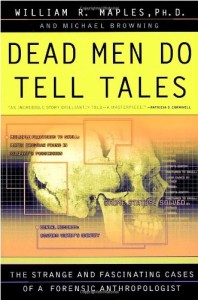Dead Men Do Tell Tales
Written by Ashley Kelmore, Posted in Reviews
I earn my living, in part, by planning for what to do when a whole lot of people die all at once. Yes, that is actually a real job, and hopefully one that exists in your city or state. There are a lot of people around the country who do what I do, and earlier this year I attended a conference of such folks. I chose to read this book during that conference; it seemed fitting.
Dead Men Do Tell Tales is a fascinating, detailed book by Dr. William Maples, an amazingly accomplished forensic anthropologist. You may be familiar with that field if you watch “Bones,” although as is usually the case, what you see on screen doesn’t closely match reality. A forensic anthropologist is trained in examining human remains to learn more about the decedent. They can tell if bones belonged to a woman or man, approximate age, and explain wounds. It’s very detail-oriented work, at times taking months or years when the identity is unknown (not the 45 minutes plus commercials Emily Deschanel might suggest).
In his book from the 90s, Dr. Maples takes the reader through many different cases he’s participated in over the years. Some involve people you’ve never heard of, and some are so famous it would be understandable if you didn’t quite believe what you were reading. Dr. Maples was, no joke, part of the small team that confirmed the identity of the bones of the murdered last Tsars of Russia. He put to rest the idea that President Taylor was killed by arsenic poisoning. He also helped convict murderers whose crimes were devastating but whose names you and I might not recognize.
As evidenced by my line of work, I find this to be an extremely interesting topic. I’ve read Mary Roach’s Stiff, as well as a couple of other books about the lives of medical examiners. If nothing else is on TV, I’ll likely leave it tuned to Dr. G. Medical Examiner or some other disease-related show on TLC or Discovery. I say all of that in service of the recognition that this type of writing is just not for everyone.
It is EXTREMELY graphic. Not to shock, but to explain. How else can he express to you how he was able to identify a murder weapon than to explain how he matched it to the wounds to the victim’s bones? Without the detail, it would be a very short book, with each chapter consisting of “so I did my work and concluded X.” His way of writing is so much better – it makes sense, and gives the reader a real insight into how forensic anthropology works.
If you enjoy history, or true crime stories, or science, and are not easily sickened by detailed descriptions of human remains, I think you’ll really enjoy this book. The only reason I gave it four stars is because at times the non-forensic writing (the set-up to the crime, or background) is a bit too flowery for my tastes. I appreciate creative turns of phrase, and I don’t doubt that the authors really do write this way, but at times it felt a little like one of them just got a new thesaurus. Additionally, while it suits the structure of the book, each chapter feels like its own independent essay; he re-explains some things as though the reader hadn’t just learned about them 50 pages prior.
But those are minimal complaints. It’s a great book.

